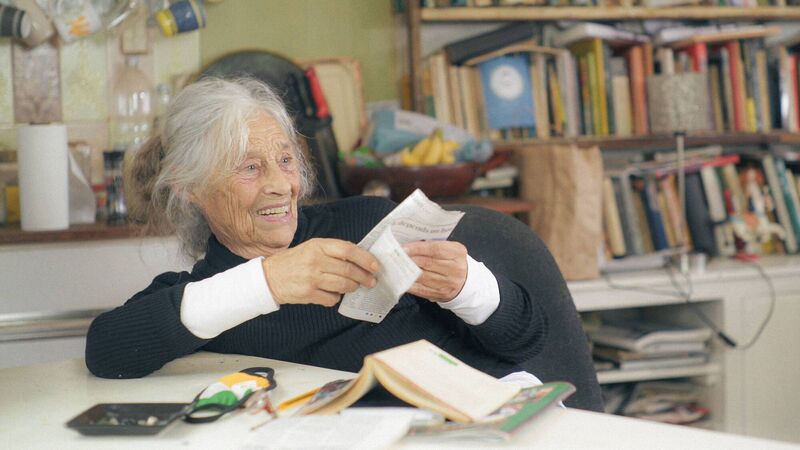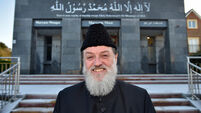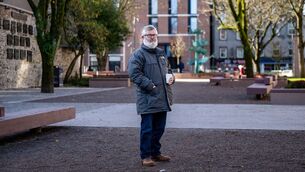Clodagh Finn: You can tell the story of a lifetime in how you see a bright May day

Margaretta D’Arcy in 'Mad, Bad, and Dangerous, a celebration of 'difficult' women', showing as part of Age & Opportunity's Bealtaine Festival. Picture courtesy of Cathy Dunne
I USED to think it was hilarious when my mother looked out the window on a bright May day and said: “It’s a great day for drying.”
What a way to think of a fine day, I used to think, when you could be out under that blue sky doing so many other things.
But, oh, how we become our mothers. Give me a good day now and I’ll assess it in terms of drying potential, then excavate for colours or whites in the never-empty laundry basket.
What I didn’t realise before, however, was that wasn’t the only way my mother saw a fine day in May. Her drying forecast was layered through with so many other memories that I didn’t see.
That often happens when younger people look at older people; they see a person struggling with the payment machine in the underground car park, to give one example, and reduce a lifetime to a single action in the present.
I was guilty of it myself, and that myopia came back to haunt me recently when I chanced across two young lads while looking at the ruins of an old house in the middle of a housing estate. Old ruins, it seems, attract two kinds of people: Young ones looking for cover from adult eyes and older ones interested in history.
When I approached, the young lads looked at me guiltily and hid something from view — a cigarette, a bottle, a dodgy phone video, or a joint, I’m guessing. What they didn’t know was that I was once one of them, seeking out a secluded spot to misspend a little bit of my youth. Not all older people sought refuge in those furtive places, but I think it’s safe to say that, without exception, all of them have stories to tell.
That point will be illustrated gloriously in the coming month during Age and Opportunity’s Bealtaine Festival, the national celebration of the arts and creativity as we age. Take , for instance. The documentary series created by theatre artist Emma O’Grady will be celebrating ‘difficult’ women over the age of 70.
Bring it on.
“They were moving mountains long before hashtags,” says the Bealtaine programme, which announces an online repeat of the first series and the premiere of series two. There’s an upcoming online discussion too, on May 18 at 6pm. Check it out if you are interested in the brass necks of these sharp and fearless ‘difficult’ women, as they are billed.
Among the line-up are Lelia Doolan, Bernadette McAliskey, Margaretta D’Arcy, Pauline Cummins, Jo Murphy Lawless, and Nell McCafferty, all trailblazers with much to say.
The Bealtaine Festival programme also makes this really important point: “With the pandemic, the relationship that intersects age, gender, and public space has never been so fraught. The need to see, hear, and prioritise older people has been rendered explicitly visible.”
It really has and — if you take a moment to consider it — you can tell the story of a lifetime in how you perceive a bright May day. That is how it seems to me, anyway, as this hopeful time of year swings around prompting a gush of memories.
If only we could see that the older person looking out on a dry May day was once a child playing hopscotch, we might close the yawning gulf between generations that often makes us so shamefully dismissive of older people.
This older person, for instance, was once a seven-year-old sitting at a windowsill with a bird book, trying to identify the feathered visitor to our bird table. I’m still at it, but thanks to those early days I know who visits now and am thrilled, beyond reason, to see that a pair of blue tits are nesting in one of our wooden birdhouses this year.
May also reminds me of a brief religious phase when, pre-First Holy Communion, we were encouraged to kneel before our own May altars and recite fervent petitionary prayers. It didn’t last very long but every time I see a shimmering bluebell, the innocence of that simpler time returns.
May days, though, have not always been so gentle. I remember blinking into them while revising for exams and cursing the sun that could be depended on to beat down on us once the exams started. Even so, we stepped out into it, against advice — ‘ne’er cast a clout till May is out’ — slathering ourselves in questionable oils to bring a flush to milky white skin.
Later, we’d wear sunglasses to keep the brightness off hungover eyes. There is nothing as cock-sure as a learner drinker full of alcohol who is under the (very mistaken) impression that they are both invisible and invincible. The seemingly beige elder you see in front of you has many stories to tell.
May, to my mind, is also the month of workers, even if International Workers’ Day, on the first, has gone by. If the pandemic has highlighted the need to value older people, it has also reminded us to see, hear, and prioritise the armies of unseen workers — shop assistants, carers, community workers, delivery workers — without whom the world would grind to a halt.
Yesterday, representatives from the community and voluntary sector warned of going on strike if the Government didn’t engage on funding. During the pandemic, we saw how this sector provided vital health and social services to the most vulnerable in our community. Yet, many of them are poorly paid and have little or no pension provision, according to their union.
Maybe we have grown blind to the imploring outstretched arms of the statue of trade union leader Jim Larkin on O’Connell St in the centre of Dublin. I wonder if it would make any difference if we commemorated those early female trade unionists, such as Delia
Larkin, Big Jim’s criminally overlooked sister, who co-founded the Irish Women Workers’ Union with Rosie Hackett, as many of the low-paid workers are women.
Cork City authorities might even consider erecting a plaque (at the very least) to Cissie Cahalan (1876-1948), a Cork-born draper’s assistant, who was key in helping 450 shop assistants win a 30% pay increase from Arnotts department store in 1918.
She was an excellent public speaker, too, and I wonder what she might say about the lot of shop workers more than a century on; those too-little-heralded heroes of the pandemic frontline. There’s a thought to consider for next year’s May Day.
Back in the present, though, this is a good time to embrace the ideals of the Bealtaine Festival which, in the organisers’ words, “demonstrates and celebrates how our creative potential can improve with age”.
Even on a great drying day.












